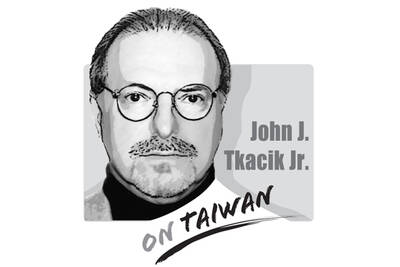If there is one thing that the White House wants us to know about the new tariffs that promise to upend the global economy, it is that they are “reciprocal.”
We now know that they are not reciprocal at all. In fact, they bear no connection whatsoever to any levies that the target country might impose on US exports. They are simply designed to be proportional to that country’s trade deficit with the US, adjusted for the size of their bilateral trade.
That is not a formula that anyone expected — for good reason, since no economic or moral logic justifies it. However, in retrospect it appears a natural consequence of how US President Donald Trump erroneously conceives of global trade. Tragically, Trump’s misconceptions also mean that his policy choices would be way worse for US consumers, investors and partners.

Illustration: Yusha
Suppose you, like Trump, want to reduce the US’ overall trade deficit with the world to zero. Forcing your bilateral trade deficit with each country down to zero — the ultimate aim of that tariff formula — is an absurdly inefficient way to go about it.
In fact, tariffs proportional to a country’s trade deficit with the US actually seem designed to maximize the pain to US consumers. The very countries that have retooled their economies to serve the US’ needs have been rendered disproportionately uncompetitive. The tariffs on them are higher. They would falsely appear less efficient than other economies that have spent decades failing to produce things Americans want at prices they would pay.
Let us look at a specific example: Bangladesh and India. The former has long been dependent on the export of clothing to the West. Since a tragic fire in one of its factories a decade ago, it has worked hard to upgrade labor standards; its hundreds of efficient textile mills have painstakingly learned how to produce clothes that fit any given quarter’s trends, are of acceptable quality and cost less than if they were made anywhere else.
Therefore, Americans buy more Bangladeshi-made clothes than from Indian factories. India’s sector is relatively inefficient, with smaller factories that cannot fulfill large orders and have fewer experienced workers.
The world has been turned upside down: Thanks to their failure to attract US buyers, Indian-made garments would be tariffed at 26 percent — 11 percentage points lower than the Trump tariff on Bangladesh, at 37 percent. In this industry, a couple of percentage points of margin are sufficient for contracts to shift. With an 11-point buffer, inefficient Indian garment factories should now outcompete Bangladesh — and Vietnam and Cambodia — without even trying. That is great news for Indians — and exactly the sort of mad irrationality that many policymakers in New Delhi were hoping for from the new “Washington consensus.”
Indian-made garments might now be cheaper than those from Bangladesh, but US-based factories are still uncompetitive with both of them. The cost difference in bulk orders between India and Bangladesh might be 10 percent, an unbridgeable chasm in this business. However, the cost difference between Bangladesh and the US is an order of magnitude greater. US-based shirts can be two or three times as expensive to produce.
Forget about fairness for a moment. Yes, Vietnam might have taken a generations-long bet on friendship and integration with a country that was within living memory bombing its villages. And yes, that bet might have been shown, in the course of a single afternoon, to be a grave national mistake. Nobody in the White House would care about that.
Trump has deliberately targeted his own voters with those tariffs. A flat duty would reduce consumer welfare, raising prices for everyone. However, it would have, for a while, retained the supply chains developed over decades to serve the US.
And if you believe, like Trump, in a manufacturing renaissance behind tariff walls, a flat tariff is the only thing that could work. A constant duty of 20 percent would give a clear target for possible investors in US garments: Get bulk costs to within 20 percent of Bangladesh and you are set. And until the moment US manufacturing hits that target and begins substituting the most efficient foreign producer, Americans would continue to benefit from that country’s existing competence and expertise.
Instead, those proportional — not reciprocal — tariffs would ensure that US consumers are deliberately forced to buy inferior goods from abroad, not just more expensive ones. Poorer quality, pricier goods from India or Colombia (10 percent tariffs, 27 percentage points lower than Bangladesh) would suddenly turn up in US shops.
No jobs would be created. Even under optimistic scenarios, investment cannot crowd back into US garment factories now. Trump has ensured that the price target that new US manufacturing must now hit to make a profit has become high and unpredictable. Gone is the simple ask: Beat Bangladesh’s cost plus tariffs, since the market has proved they do T-shirts best, and so if you beat them, you beat everyone.
If Bangladesh faces a higher unit cost than all its competitors, investors cannot rely on the historical wisdom of the market. Instead, they now need to imagine exactly how much hypothetical Indian-made T-shirts, currently priced out by Bangladeshi factories, would cost if production shifted there from Bangladesh. They would have to repeat that for every possible competitor and revisit it every year depending on which country attracts productivity-enhancing investment in the post-proportional tariff world.
If that sounds like a nightmare, you are not wrong. In fact, the Trump tariffs are designed to maximize uncertainty. Many hoped that they would constitute a single hit to prices, and any inflationary bump would be “transitory.” However, that tariff formula almost guarantees that uncertainty is ongoing and inflation would be sustained.
That is because those trade restrictions do not just fight economic theory, they are designed to battle 20 years of cumulative market wisdom — the wisdom that decided not just that Vietnam was cheaper than the US, but also that it was more efficient than Indonesia. For his voters, Trump’s tariffs have unleashed the worst of all possible worlds.
Mihir Sharma is a Bloomberg Opinion columnist. A senior fellow at the Observer Research Foundation in New Delhi, he is author of Restart: The Last Chance for the Indian Economy.

Somehow, US intelligence identified “the Houthis’ top missile guy” and pinpointed his exact location. At 1348 hours (Washington time), March 15, President Trump’s national security advisor Mike Waltz texted, “positive ID of him walking into his girlfriend’s building.” The unsuspecting Romeo entered. High above, the drone monitoring the building registered a flash. When the smoke cleared, Mr. Waltz texted, “…And it’s now collapsed.” RIP. The star-crossed “top missile guy” had been target number one in the now uproarious US Navy bombing campaign on that Sunday against the Yemeni rebels who have been holding the Red Sea hostage since October 19,
Actress Michelle Yeoh (楊紫瓊) on March 13 posted an Instagram caption after the opening of Tiffany’s Taipei flagship store two days earlier that read: “Thank you Tiffany for inviting us to Taipei China.” We know that Yeoh knows Taipei is in Taiwan, not China, because the caption was posted following comments she made — in English — in which she said: “Thank you to Tiffany for bringing me to Taipei, because I do love this country very much.” Her remarks and the subsequent Instagram caption were reported in Taiwan, in Chinese and English- language media such as Radio Free Asia, and overseas,
China on Tuesday, April Fool’s Day, began two-day joint-force military exercises around Taiwan, painting them as a “severe warning and forceful containment against Taiwan independence.” However, the exercises have again proven the country increasingly showcasing its military muscles to be a true “troublemaker.” Without prior notice, the Chinese People’s Liberation Army’s (PLA) Eastern Theater Command launched large-scale exercises codenamed “Strait Thunder-2025A,” deploying aircraft, drones and naval vessels including the Shandong aircraft carrier, as well as armed militia in the air and waters around Taiwan. The PLA claimed the military exercises were practice for precision strikes and a blockade to “close
Days ago, foreign media reported that Chinese People’s Liberation Army (PLA) Eastern Theater Command Director Lin Xiangyang (林向陽) is suspected to have disappeared under suspicious circumstances. The Eastern Theater Command is the core military department responsible for operations against Taiwan — the purging of its director, if true, would be a major blow to the morale of the Chinese military and the success of its training. On Tuesday morning — April Fool’s Day — the Chinese Communist Party’s (CCP) Eastern Theater Command suddenly announced the launch of joint military exercises in the air and maritime spaces surrounding Taiwan. The exercises